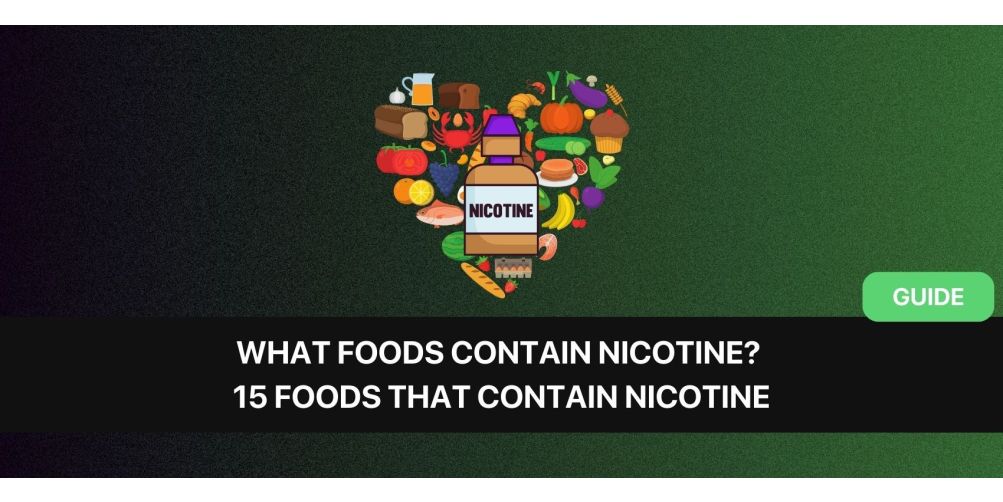Did you know that tomatoes, eggplants, and potatoes naturally contain nicotine? I was shocked when I first discovered this! While researching alternatives to tobacco products, I stumbled upon this fascinating fact that completely changed my understanding of nicotine.
Vegetables from the nightshade family (Solanaceae) naturally contain trace amounts of nicotine. Although these plants contain only a fraction of what you'd find in tobacco or nicotine pouches like ZYN or VELO. They're still worth knowing about especially if you're trying to understand your body's relationship with nicotine or working on quitting tobacco products.
What is Nicotine, and Why Does It Appear in Foods?
Before diving into the list, let's understand what nicotine actually is. Nicotine is a naturally occurring alkaloid compound found primarily in the nightshade family of plants. It acts as a stimulant in humans and is the primary addictive component in tobacco products.
Plants produce nicotine as a natural pesticide to protect themselves from insects and herbivores. Through millions of years of evolution, plants with natural deterrents like nicotine and capsaicin have developed better survival rates because these compounds repel pests. The bitter taste I notice when biting into an unripe eggplant? That's partly the plant's defensive compounds at work!
(At Snusdaddy, we find plant evolution fascinating it's remarkable how plants developed their own defense mechanisms that now affect how we experience them as food.)
9 Foods That Contain Natural Nicotine
The foods below contain only a fraction of the nicotine found in tobacco products or nicotine pouches. For comparison, a cigarette contains about 10-12 mg of nicotine, while these foods contain micrograms (μg) that's 1/1000th of a milligram.

1. Tomatoes (Do Tomatoes Have Nicotine?)
Yes, tomatoes contain nicotine approximately 7 μg per gram. An average medium-sized tomato weighing 200 grams contains about 1,400 μg (1.4 mg) of nicotine.
I've grown tomatoes in my garden for years, and the sweet-tart burst of flavor when biting into a sun-warmed cherry tomato has nothing to do with its nicotine content that comes from its perfect balance of natural sugars and acids. While the amount of nicotine isn't enough to cause any noticeable effects, tomatoes do offer significant health benefits through their lycopene content, which research in the National Library of Medicine shows supports heart health.
I've also noticed that home-grown tomatoes seem to have more vibrant flavors than store-bought ones I wonder if their nicotine content varies too? That's something we're curious about at Snusdaddy.
2. Potatoes (Do Potatoes Contain Nicotine?)
Potatoes belong to the Solanaceae family and contain approximately 15 μg of nicotine per gram. A medium-sized potato weighing 170 grams contains about 2,600 μg (2.6 mg) of nicotine.
I've discovered that green potatoes contain more nicotine up to 45 μg per gram. That's why I'm always careful to store potatoes properly and discard any that turn green. Beyond their trace nicotine content, potatoes are one of my go-to sources of potassium and vitamin C.
3. Eggplant (Aubergines)
Eggplants contain the highest concentration of nicotine among common vegetables about 100 μg per gram. The first time I cut into a fresh eggplant, I noticed a slight bitterness on my fingers where the juice touched them. That bitter compound is partly related to the plant's nicotine alkaloids.
Despite having higher nicotine content than other vegetables, eggplants are still nutritional powerhouses packed with antioxidants and fiber. I love how they transform from spongy to silky when cooked properly.
4. Bell Peppers
Bell peppers contain approximately 90 picograms of nicotine per gram that's significantly less than other nightshade vegetables. I've found that red bell peppers, which have ripened longer on the plant, have a sweeter, less bitter flavor than green ones, which might correlate with changes in their alkaloid content.
5. Cauliflower
Though not a nightshade, cauliflower contains about 16 μg of nicotine per gram. I was surprised to learn this, as cauliflower belongs to the Brassicaceae (cabbage) family, not Solanaceae.
When I roast cauliflower until it's golden and caramelized, the nutty flavor that develops is completely unrelated to its minimal nicotine content. It's more about the natural sugars caramelizing through the Maillard reaction.
6. Green Peppers
Green peppers contain 8-9 μg of nicotine per gram. I've always preferred them in cooking rather than eating raw because their slight bitterness (which may be partly due to their alkaloid content) mellows beautifully when cooked.
Green peppers are rich in iron and vitamin C I've found they're an excellent addition to meals when I'm feeling a bit run down and need a nutritional boost.
7. Hot Peppers (Chili Peppers)
Hot peppers have one of the highest nicotine concentrations among vegetables. According to research in the National Center for Biotechnology Information (NCBI), they contain a median of 102 μg of nicotine per kg.
The burning sensation from hot peppers comes primarily from capsaicin, not nicotine. I've found that growing my own chili peppers results in more intense heat levels perhaps environmental factors affect both capsaicin and nicotine production.
8. Teas (Black and Green)
Black, green, and oolong teas contain approximately 0.7 μg of nicotine per gram. While drinking a cup of tea, I've noticed the gentle alertness it provides comes primarily from its caffeine content, not the trace amounts of nicotine.
9. Cocoa (and Chocolate)
According to the Institute of Food Technologies, chocolate contains about 7 μg of nicotine per gram. Combined with its 2.3 mg of caffeine per gram, this might partly explain why I find dark chocolate so satisfying after a meal though I'm pretty sure the rich flavor and melt-in-your-mouth texture play bigger roles!
(We keep a stash of dark chocolate at the Snusdaddy office for those afternoon energy dips works better than a nicotine pouch for most of us!)
Which Vegetable Has the Most Nicotine?
Based on current research, eggplant contains the highest concentration of nicotine among common vegetables, with approximately 100 μg per gram. Hot peppers follow closely behind. However, even the highest-nicotine vegetable contains dramatically less nicotine than tobacco products or nicotine pouches like ZYN.
For perspective, you'd need to eat several kilograms of eggplant to get the nicotine equivalent of one cigarette or nicotine pouch physically impossible in one sitting!
Nicotine Content Comparison in Common Foods
|
Food |
Nicotine Content (μg/g) |
Amount in Average Serving |
|
Eggplant |
100 |
25,000 μg in a medium eggplant (250g) |
|
Hot Peppers (Chili) |
0.1 (102 μg/kg) |
5 μg in a small chili (50g) |
|
Potatoes |
15 |
2,600 μg in a medium potato (170g) |
|
Cauliflower |
16 |
2,400 μg in a small cauliflower (150g) |
|
Green Peppers |
8-9 |
1,000 μg in a medium pepper (120g) |
|
Tomatoes |
7 |
1,400 μg in a medium tomato (200g) |
|
Chocolate (Cocoa) |
7 |
210 μg in a chocolate bar (30g) |
|
Bell Peppers |
0.00009 (90 pg/g) |
0.01 μg in a medium bell pepper (120g) |
|
Tea (Black/Green) |
0.7 |
1.4 μg in a cup of tea (2g of leaves) |
Why Nicotine Concentration Varies in Foods
I've noticed in my garden that nicotine levels in vegetables can vary significantly based on:
- Ripeness - Green, unripe eggplants and potatoes contain more nicotine than ripe ones
- Growing conditions - Stress, soil quality, and weather affect alkaloid production
- Variety - Heirloom varieties often have different chemical compositions than modern hybrids
- Agricultural practices - Organic vs. conventional farming methods can influence nicotine levels
This variability makes foods with nicotine quite different from nicotine pouches, which have precisely measured amounts. When I recommend products like ZYN to customers, I emphasize this consistency you know exactly how much nicotine you're getting (3mg or 6mg), unlike with natural food sources.

Can Foods With Nicotine Help You Quit Smoking?
In my experience helping people transition away from cigarettes, foods containing nicotine don't provide enough of the compound to satisfy cravings or replace tobacco products. The nicotine levels are simply too low.
However, I've found that incorporating these foods into a cessation plan can:
- Provide a psychological connection to the quitting process
- Boost overall nutrition during a challenging time
- Offer sensory experiences (taste, texture) that can distract from cravings
Many of my customers have had success combining nutritious foods with properly dosed nicotine alternatives like pouches or snus as a stepping stone to quitting altogether.
At Snusdaddy, we've helped thousands of people make the transition from smoking to less harmful alternatives knowing about nicotine-containing foods is just one small part of our expertise.
How Your Body Processes Food-Based Nicotine vs. Tobacco Products
When you eat foods containing nicotine, the compound enters your bloodstream through your digestive system a much slower process than the rapid absorption through mucous membranes that occurs with nicotine pouches or cigarettes.
I've experienced this difference firsthand: the stimulating effect from a nicotine pouch is noticeable within minutes, while eating foods with trace nicotine produces no perceptible effect at all.
This difference in absorption rate is why foods containing nicotine don't produce a nicotine buzz or satisfy cravings the way purpose-made nicotine products do.
Health Implications of Natural Nicotine in Foods
Should you worry about consuming foods that naturally contain nicotine? Absolutely not! The amounts are so minimal that they have no measurable physiological effect. In fact, avoiding nutritious vegetables like tomatoes, potatoes, or eggplants because of their nicotine content would mean missing out on valuable nutrients.
I've sometimes been asked if people trying to quit nicotine should avoid these foods my answer is always no. The health benefits far outweigh any concerns about their negligible nicotine content.
Bottom Line of Nicotine in Food & Vegetables
If you're looking for foods with the most nicotine, eggplants, potatoes, and tomatoes top the list among common vegetables. However, even these "high-nicotine" foods contain such trace amounts that they won't affect your body the way tobacco or nicotine products do.
At Snusdaddy, we're committed to helping our customers make informed choices about nicotine consumption. Whether you're curious about natural sources of nicotine or looking for alternatives to smoking, we're here to provide evidence-based information and quality products.
For more guidance on your journey, check out our comprehensive guide on how to stop using nicotine pouches or explore our wide selection of nicotine pouch alternatives.
FAQ About Nicotine in Foods
What fruits have nicotine?
Unlike vegetables from the nightshade family, fruits generally do not contain nicotine. Tomatoes are technically fruits and do contain nicotine, but other common fruits like apples, bananas, and berries do not contain measurable amounts of nicotine.
How much nicotine is in a tomato compared to a cigarette?
A medium tomato contains approximately 1,400 μg (1.4 mg) of nicotine, while a cigarette contains 10-12 mg of nicotine. However, the bioavailability differs significantly you absorb much less of the nicotine from tomatoes through digestion than you would from a cigarette through inhalation.
Which nightshade vegetables contain nicotine?
Nightshade vegetables containing nicotine include tomatoes, potatoes, eggplants, and peppers (both bell peppers and hot peppers). The nicotine serves as a natural pesticide to protect these plants from insects and other predators.
Can eating nicotine-containing foods affect a drug test?
No, consuming foods with natural nicotine will not affect a nicotine drug test. The amounts are too small to register on standard nicotine tests, which are calibrated to detect the higher levels associated with tobacco use or nicotine replacement products.



